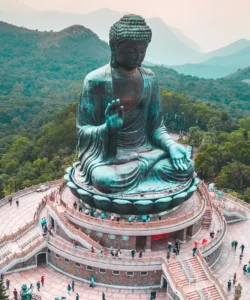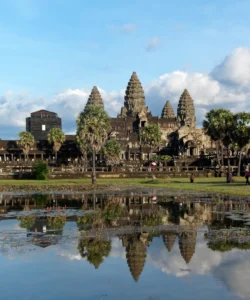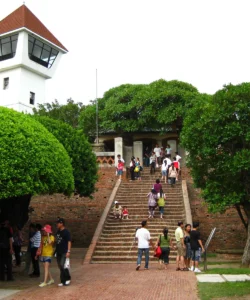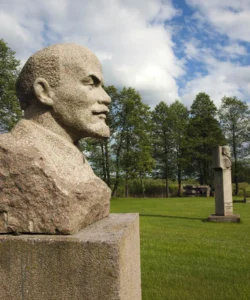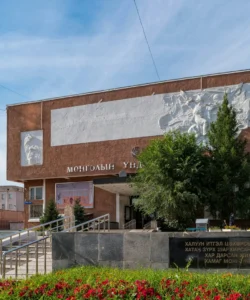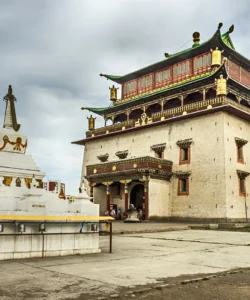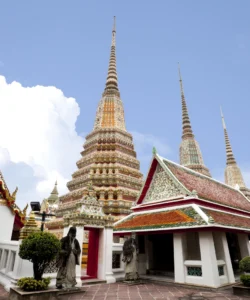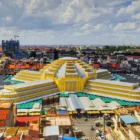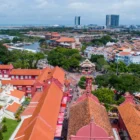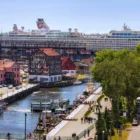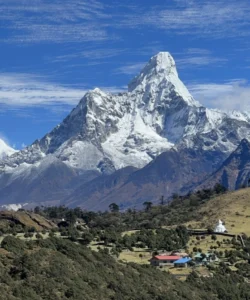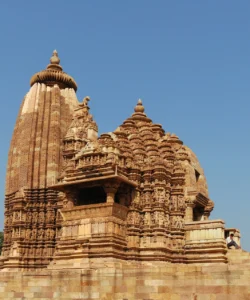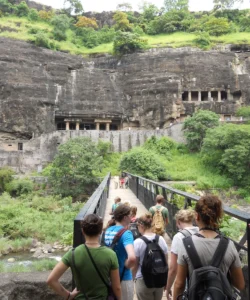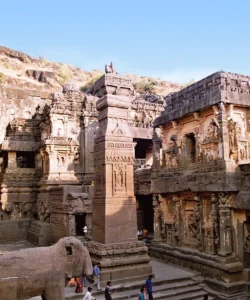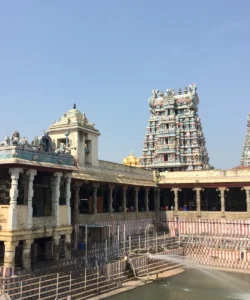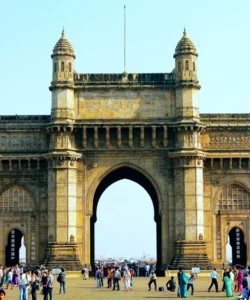The Ellora Cave Temples are an extraordinary archaeological site in Maharashtra, India, representing one of the largest and most impressive rock-cut cave complexes in the world. What makes Ellora truly unique is its harmonious blend of monuments dedicated to three different major religions: Buddhism, Hinduism, and Jainism, all carved side-by-side from the same high basalt cliff face.
Name: Ellora Cave Temples (locally known as ‘Verul Leni’)
Address: Aurangabad-Chalisgaon Road, Verul, Maharashtra 431102, India.
The caves are located in the Charanandri Hills, approximately 30 kilometers (18 miles) northwest of Aurangabad, the district headquarters in Maharashtra, India. They are carved out of a nearly 2-kilometer long scarp of a basalt plateau.
How to Get There:
Aurangabad is the primary gateway city for visiting Ellora Caves.
- By Air: The closest airport is Aurangabad Airport (IXU), which has direct flights from major Indian cities like Mumbai, Delhi, and Hyderabad. From Aurangabad Airport, you can hire a taxi or auto-rickshaw to Ellora (approx. 1-hour drive).
- By Train: Aurangabad Railway Station (AWB) is well-connected by trains from various cities across India. From the railway station, you can take a taxi or auto-rickshaw to Ellora.
- By Bus: Numerous private and government buses run from major cities in Maharashtra to Aurangabad. From Aurangabad Central Bus Station, local buses frequently go to Ellora village, which is about a 2 km walk from the caves, or you can take a taxi/auto-rickshaw directly to the entrance. The Maharashtra State Tourism Development Corporation (MTDC) also offers organized bus tours.
- By Taxi/Auto-rickshaw: Easily available from Aurangabad for a direct trip to Ellora. Many visitors hire a taxi for a full day to combine Ellora with other nearby attractions like Daulatabad Fort and Bibi Ka Maqbara.
- Important Note: The caves are generally open every day except Tuesdays. It’s best to arrive early to avoid crowds and the heat. Shuttle buses are available within the complex to transport visitors between different cave groups.
Landscape and Architecture:
The “architecture” of Ellora is not built structures in the traditional sense, but rather monumental spaces, temples, and monasteries entirely carved out of the living basalt rock of the Charanandri Hills. This “rock-cut architecture” is a unique and challenging form of construction.
- Basalt Cliff Face: The 34 main caves are excavated into the vertical face of a high basalt cliff, formed from the ancient Deccan Traps volcanic activity. The cliff runs in a semi-circular arc, with the Buddhist caves at one end, the Jain caves at the other, and the Hindu caves in the center.
- Religious Harmony in Stone: What makes Ellora’s layout truly extraordinary is that it features an uninterrupted sequence of monuments dedicated to three different religions:
- Buddhist Caves (Caves 1-12): Dating from around 600-700 CE, these typically consist of viharas (monasteries with living quarters, cells, and halls) and chaityas (prayer halls with stupas). They are characterized by their simple, austere design and serene sculptures of Buddha and Bodhisattvas. Cave 10, the Vishvakarma Cave or “Carpenter’s Cave,” is famous for its vaulted ceiling meticulously carved to imitate wooden beams.
- Hindu Caves (Caves 13-29): Dating from around 600-900 CE, these are generally grander and more elaborate, with intricate carvings depicting Hindu deities (Shiva, Vishnu, Durga, Ganesh) and mythological scenes from epics like the Ramayana and Mahabharata. They often feature axial floor plans with mandapas (halls) and garbhagrihas (sanctums).
- Jain Caves (Caves 30-34): Dating from around 800-1000 CE, these are smaller but highly intricate, known for their ascetic design and detailed sculptures of Jain Tirthankaras (saints) and symbolic motifs. Cave 32, the Indra Sabha, is a notable two-story Jain cave with elaborate carvings and a beautifully adorned shrine.
- Kailasa Temple (Cave 16): This is the undisputed centerpiece and the most breathtaking achievement at Ellora. It is not a cave within the rock, but an entire multi-storied temple carved out of a single, massive piece of solid rock, from the top down. It’s an astounding feat of engineering and artistry, simulating a freestanding structural temple, complete with a massive courtyard, a gateway, a central shrine dedicated to Lord Shiva, and numerous subsidiary shrines and pillars. Its scale and intricacy are mind-boggling, estimated to have involved the removal of 200,000 to 400,000 tons of rock.
- Intricate Sculptures and Reliefs: All caves, regardless of religion, are adorned with a profusion of highly detailed sculptures and bas-reliefs, showcasing the artistic brilliance of ancient Indian craftsmen. These provide invaluable insights into the religious practices, mythology, and daily life of the period.
- Water Features: During the monsoon season (June to September), natural waterfalls cascade down the cliff face, particularly near Cave 29 (Dhumar Lena), adding to the beauty of the site and historically integrated into some of the cave designs.
What Makes It Famous:
- UNESCO World Heritage Site: Designated in 1983, Ellora is globally recognized for its unique artistic creation and technological exploit, and for embodying the spirit of tolerance characteristic of ancient India.
- Largest Rock-Cut Monolithic Temple (Kailasa Temple, Cave 16): The Kailasa Temple is unparalleled as the largest single monolithic excavation in the world. It’s a full-scale temple carved out of rock, rather than a cave in a rock, an architectural and engineering marvel that leaves visitors awestruck.
- Religious Harmony and Tolerance: Ellora is famously the only site in India (and perhaps the world) where monuments of three major religions—Buddhism, Hinduism, and Jainism—coexist side-by-side in a single complex, demonstrating a remarkable spirit of religious tolerance and peaceful coexistence in ancient India from the 6th to 10th centuries CE.
- Diversity of Rock-Cut Architecture: It showcases the zenith of Indian rock-cut architecture, with examples ranging from simple monastic cells to elaborate multi-story temples, illustrating the evolution and innovation of this art form.
- Detailed Iconography and Mythology: The caves are a rich tapestry of Hindu, Buddhist, and Jain iconography, providing extensive visual narratives of their respective mythologies, deities, and spiritual philosophies.
- Engineering Prowess: The sheer scale of excavation, the precision of carving, and the complexity of designs (especially the top-down carving of Kailasa) highlight extraordinary engineering and artistic skills without modern tools.
Differences from Some Other Wonders:
- Multi-Religious Coexistence: The most significant difference from other temple complexes (like Borobudur, a Buddhist monument; Prambanan, a Hindu complex; or Meenakshi Amman Temple, a Hindu temple) is Ellora’s unique simultaneous representation of three distinct major religions (Buddhism, Hinduism, Jainism) within the same contiguous complex. This makes it a profound symbol of ancient Indian religious tolerance.
- Rock-Cut vs. Built Structures: While many wonders are built structures (Taj Mahal, Red Fort, Angkor Wat), or even rock-cut into a mountain (like Petra or perhaps parts of Ajanta), Kailasa Temple at Ellora is a freestanding, multi-story temple carved out of a single, solid piece of rock, literally from the top down. This is fundamentally different from adding stone blocks to build upwards. This massive monolithic carving makes it a unique feat.
- Emphasis on “Cave” Temples: While the term “cave” is used, many of these are grand, open-air complexes or large halls excavated from the cliff, offering a different spatial experience than natural caves (like Batu Caves, which are natural caverns adapted for religious use).
- Continuous Evolution Over Centuries: The caves were excavated over a period of approximately 400 years (6th to 10th century CE), showcasing the evolution of architectural styles and religious practices across different dynasties and beliefs within a single site. This long period of continuous activity makes it a unique historical record.
- No Active Daily Worship (for most): While some shrines within Ellora might still see occasional worship, it is primarily an archaeological and historical site for visitors, rather than a bustling, continuously active pilgrimage center like the Meenakshi Amman Temple.
- Geological Context: The caves are carved into the Deccan Traps, a specific volcanic basalt formation, which means the rock itself is a defining characteristic of the material and method of construction.
Ellora Cave Temples Photos:































